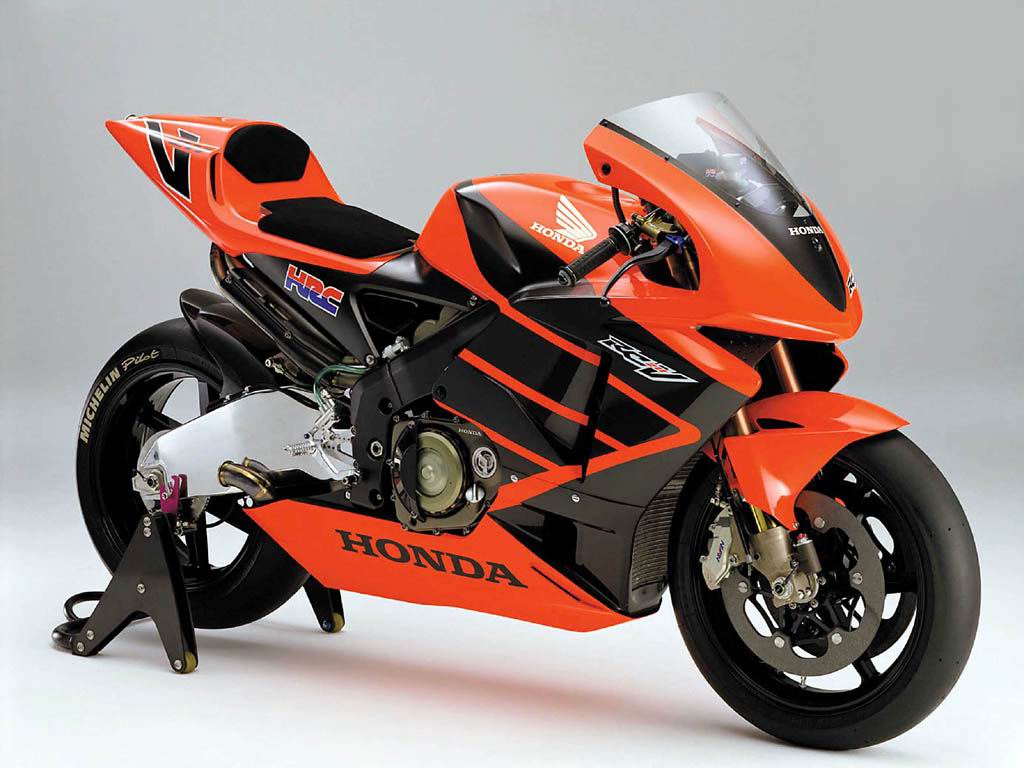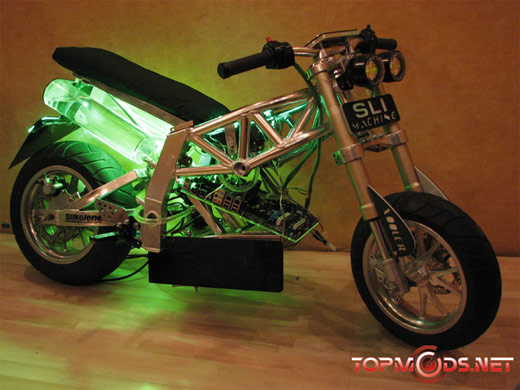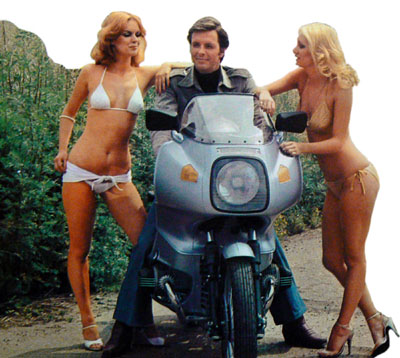|
|---|
Thursday, September 30, 2010
COMUNE 'KARLSON TEA PARTY'
Last Saturday night the artist's collective Comune held their second annual 'Karlson Tea Party' (no relation to the political entity) in Costa Mesa, CA. The point of the exercise, beyond attracting the hippest crowd in Orange County that night, was a display of photographs by Adam Wright ('Hauler' and 'Road Course' photo 'zines) and skate/motorcycle photographer Scott Pommier, plus a curated selection of motorcycles, all but one customized, by Cole Foster, Ian Barry, Trevelen Rabanal, Kiyo, Kutty Notebloom, and John Edwards (the non-custom bike was a Harley KRTT racer, provided by Yoshi Kosaka of the Garage Company).
Set up in a large parking lot bordered by the Comune store and a converted shipping container which served as the art gallery, the bikes on display were dramatically lit in the dark outdoor space, making them the center of attention, while about 60 ride-in bikes were parked nearby, some of them as interesting as the display machines...surely a hallmark of any worthy bike event.
The aesthetics of the display machines ranged from an 'old school/old paint' Knucklehead bobber, exotic 60s-style art creations (the 'Plum Smuggler'), super clean and minimal contemporary customs (Cole Foster), classic extended-fork choppers, and a pair of Ian Barry's tour-de-force Falcons.
Bikes in the parking corral were half Harley-based with a range of styles, plus a large British custom contingent, and a few modified Japanese machines, including the brilliant street-scrambler which never was but looks like it ought to have been, the Yamaha CT175/XS650 hybrid below, created by Sabrina Azam and Michael Cook.
I've attended motorcycle events of every stripe, all around the world, for decades now, and the heady mix of well-executed motorcycles, talented photographers, plus a crowd which, beyond the core of bike lovers, included a swelling throng of the young, beautiful, and über hip, were proof that motorcycles are just about the hottest fashion accessory around in 2010.
Thus, amongst the attendees, I would estimate more than half were motorcyclists, while a very visible contingent could be termed 'motorcycle-friendly' - gorgeous young women and men from the 'OC' and beyond. Throw in half a dozen Hell's Angels, and the scene harkened back to the heady days of the late 1960s, when the HA were considered 'outlaw brothers of the counterculture', and accessorized the parties of chic society. The wheel goes 'round, as they say.
The difference today, 40 years later, is a lack of crazed drugginess...which gives me hope we can avoid another Altamont.
Thanks to the Comune for inviting me to their party; the music was great! (For a short video from the event, click here).
Labels:
Motorcycle Show
Monday, September 27, 2010
CANNONBALL: THEY MADE IT!
After two weeks and 3200 miles, the Motorcycle Cannonball Endurance Rally arrived at Santa Monica pier, relatively intact, looking none the worse for their experience, and quite relieved to be finished! A hero's welcome awaited them as a crowd of nearly 2000 people waved flags and banners, cheered frantically, and crowded the finisher's path, each elbowing their way forward to see and photograph this unique scene.
It was a hard run. Most of the riders felt comfortable with the 'sitting on a 100 year old bike for two weeks', as sprung saddles and forks are generally a step up from bicycling...although one rider (Bill Rodencal) had no suspension at all - not even on the saddle - and truly wins my respect as an 'iron butt'.
What became less than comfortable for many competitors was the Minimum Daily Requirement of maintenance, as those thousands of miles included hundreds of hours dismantling/repairing/fabricating vital parts, and 'endurance' became the very watchword.
Several motorcycles didn't make the distance, and arrived on sidecar floats or in the back of the chase vehicles...melted cylinder heads, irreplaceable pistons, the nth broken crankshaft, became a nearly insurmountable obstacle to some. Others, perhaps just that much more stubborn - like Pete Young and Jon Szalay - repeated total crankshaft remanufacture several times, at a huge cost of time, and a bit of money too.
The crankpin on Pete's 1913 Premier broke twice - on the very first day, when a local machine shop worked through a weekend night to copy a new pin, gratis - and a week later in Texas, where the generosity was thin, and Pete 'had to pay through the nose' for his third pin of the rally. Inconsistent oiling (via a hand pump only), high ambient and running temperatures (crossing Oaklahoma isn't exactly a picnic jaunt in Surrey), and the need to keep up with the pack, meant the Premier was tested in a way never intended or even conceived by the manufacturer.
Jon Szalay similarly ran through three connecting rods on his 'Silent Grey Fellow' Harley, as they snapped like carrots under similar strain of its no-gear direct belt drive. Jon had planned ahead and included a rod in his spares kit, but the need for a second spare rod was unforseen. Now he has an epic tale of sitting dejected at a café, lamenting his broken Harley to a local farmer, who brightened up and said, 'You don't need an automotive rod - you need a tractor rod! I have just the thing!', and took him 40 miles into the boondocks to his barn, where he dug through an enormous pile of engine parts, to emerge with the gleaming New Old Stock item, which had the center-to-center length dimensions Jon's H-D needed. 'A few' hours spent machining the rod ('it was beautiful steel', says Jon) down to the width required, and he was left only to make a new plain bearing for the big-end. The farmer was kind enough to give him the special graphite-impregnated bronze rod necessary, and Jon made the rest of the journey without such trouble again.
Every rider save one had such tales (I didn't catch his name - he rode a '15 H-D) of repairs made on the fly, coping with seizures and flats, using beer cans, worm clips, and duct tape to keep the beasts together. But, in the end, most of them made it. I predicted mechanical carnage from the start, and indeed it happened, but the determination of all the riders to press on regardless shows just what Real Riders are made of.
During the two weeks ride, enduring bonds were formed between some of the riders, who had perhaps heard of each other previously, but a swap-meet greeting or AMCA meet affords little time to truly get to know another rider, who might live across the country. Several entrants spoke of 'learning who you love' during their time together, and I heard not a word of the opposite, such was the respect each of them grew for each other in this less-than-rational endeavor.
And, it was a competition, and there were winners - three in fact from the three classifications; 1. Single-cylinder, single speed 2. Twin and Four-cylinder, single speed 3. Single,Twin, and Four cylinder, 2 and 3 speed gearboxes.
In category 1, the most 'primitive' form of motorcycling - no gears, no clutch, just an engine, and a belt connecting a pully on the crankshaft and the rear wheel - was Katrin Boehner on her 1907 JAP 250cc single. The JAP itself is an extremely rare motorcycle, as J.A. Prestwich and Co. produced motorcycles for a very brief moment before WW1, before concentrating entirely on engine production.
As the JAP is direct-drive and clutchless, Katrin had to 'kill' her engine at every stop, and run-and-bump the JAP into life when the traffic lights turned green. To stir your imagination; on the final run into Santa Monica, the Cannonball route passed through 55 stoplights, without a police escort to scoot them through non-stop. Needless to say, after 3300 miles of such antics, Katrin is in excellent physical condition! (The JAP is one of only two overhead valve machines on the ride - the other being a Pope single-cylinder.) She won the top Cannonball prize, well deserved, of a one-off Jeff Decker sculpture of 'Cannonball' Baker himself. Bravo Katrin!
Bradford Wilmarth won category 2 on his 1913 Excelsior, and Rick McMaken and his 1915 Harley Davidson won the multi-gear award - both received original artwork related to Cannonball history. Congratulations to all!
It was a hard run. Most of the riders felt comfortable with the 'sitting on a 100 year old bike for two weeks', as sprung saddles and forks are generally a step up from bicycling...although one rider (Bill Rodencal) had no suspension at all - not even on the saddle - and truly wins my respect as an 'iron butt'.
What became less than comfortable for many competitors was the Minimum Daily Requirement of maintenance, as those thousands of miles included hundreds of hours dismantling/repairing/fabricating vital parts, and 'endurance' became the very watchword.
Several motorcycles didn't make the distance, and arrived on sidecar floats or in the back of the chase vehicles...melted cylinder heads, irreplaceable pistons, the nth broken crankshaft, became a nearly insurmountable obstacle to some. Others, perhaps just that much more stubborn - like Pete Young and Jon Szalay - repeated total crankshaft remanufacture several times, at a huge cost of time, and a bit of money too.
The crankpin on Pete's 1913 Premier broke twice - on the very first day, when a local machine shop worked through a weekend night to copy a new pin, gratis - and a week later in Texas, where the generosity was thin, and Pete 'had to pay through the nose' for his third pin of the rally. Inconsistent oiling (via a hand pump only), high ambient and running temperatures (crossing Oaklahoma isn't exactly a picnic jaunt in Surrey), and the need to keep up with the pack, meant the Premier was tested in a way never intended or even conceived by the manufacturer.
Jon Szalay similarly ran through three connecting rods on his 'Silent Grey Fellow' Harley, as they snapped like carrots under similar strain of its no-gear direct belt drive. Jon had planned ahead and included a rod in his spares kit, but the need for a second spare rod was unforseen. Now he has an epic tale of sitting dejected at a café, lamenting his broken Harley to a local farmer, who brightened up and said, 'You don't need an automotive rod - you need a tractor rod! I have just the thing!', and took him 40 miles into the boondocks to his barn, where he dug through an enormous pile of engine parts, to emerge with the gleaming New Old Stock item, which had the center-to-center length dimensions Jon's H-D needed. 'A few' hours spent machining the rod ('it was beautiful steel', says Jon) down to the width required, and he was left only to make a new plain bearing for the big-end. The farmer was kind enough to give him the special graphite-impregnated bronze rod necessary, and Jon made the rest of the journey without such trouble again.
Every rider save one had such tales (I didn't catch his name - he rode a '15 H-D) of repairs made on the fly, coping with seizures and flats, using beer cans, worm clips, and duct tape to keep the beasts together. But, in the end, most of them made it. I predicted mechanical carnage from the start, and indeed it happened, but the determination of all the riders to press on regardless shows just what Real Riders are made of.
During the two weeks ride, enduring bonds were formed between some of the riders, who had perhaps heard of each other previously, but a swap-meet greeting or AMCA meet affords little time to truly get to know another rider, who might live across the country. Several entrants spoke of 'learning who you love' during their time together, and I heard not a word of the opposite, such was the respect each of them grew for each other in this less-than-rational endeavor.
And, it was a competition, and there were winners - three in fact from the three classifications; 1. Single-cylinder, single speed 2. Twin and Four-cylinder, single speed 3. Single,Twin, and Four cylinder, 2 and 3 speed gearboxes.
In category 1, the most 'primitive' form of motorcycling - no gears, no clutch, just an engine, and a belt connecting a pully on the crankshaft and the rear wheel - was Katrin Boehner on her 1907 JAP 250cc single. The JAP itself is an extremely rare motorcycle, as J.A. Prestwich and Co. produced motorcycles for a very brief moment before WW1, before concentrating entirely on engine production.
As the JAP is direct-drive and clutchless, Katrin had to 'kill' her engine at every stop, and run-and-bump the JAP into life when the traffic lights turned green. To stir your imagination; on the final run into Santa Monica, the Cannonball route passed through 55 stoplights, without a police escort to scoot them through non-stop. Needless to say, after 3300 miles of such antics, Katrin is in excellent physical condition! (The JAP is one of only two overhead valve machines on the ride - the other being a Pope single-cylinder.) She won the top Cannonball prize, well deserved, of a one-off Jeff Decker sculpture of 'Cannonball' Baker himself. Bravo Katrin!
Bradford Wilmarth won category 2 on his 1913 Excelsior, and Rick McMaken and his 1915 Harley Davidson won the multi-gear award - both received original artwork related to Cannonball history. Congratulations to all!
Labels:
Vintage Rides
Wednesday, September 22, 2010
LATEST BROUGH SUPERIOR: T.E. LAWRENCE REPLICA
The headline could simply read, 'The World's Most Expensive Production Motorcycle', as indeed it seems Brough Superior holds that distinction, then as now. And, while the term 'production' may be stretched a bit by actual numbers in the metal to date (three!), I'll take Mark Upham, president of Brough Superior Motorcycles, at his word that he fully intends to build his 'SS101' models on a regular basis in the foreseeable future, or at least as long as there is demand at the very top of the pyramid.
The latest Brough is a full-on replica of T.E. Lawrence's 1926 mount, 'George IV', so named after George Brough himself (with a nod to several Kings George of course), the middle number of Lawrence's 8 Broughs, and perhaps his best known, as it forms the central character of his most famous essay from 'The Mint' ('The Road' - which can be read in full here), an account his ride on 'George IV' across the English countryside, and his encounter/race with an RAF Bristol biplane.
As the factory build sheet still exist for this machine, and several photographs document Lawrence astride the actual bike, it was a fairly straightforward exercise to build a replica...excepting of course that every part of an SS100 as it came from BS was a one-off, and thus there were no patterns for the 'extras' which TEL specified, and they all had to be scaled up from photographs, with invisible details such as luggage latches, his service cane, etc, all requiring investigation for period authenticity. Such is the obsession of Brough collectors (including Mr. Upham himself) with Lawrence of Arabia, and historical accuracy.
The 'Lawrence Replica' débuted at the 2010 Pebble Beach Concours d'Elegance last month, at the Brough Superior stand within the RetroAuto tent, which was actually open from Thursday thru Sunday, and was accessible at no charge (barring the $10 fee for vehicle access to 17-Mile Drive, motorcycle or car). As last year, a very handsome display was assembled by US Brough importer Bryan Bossier (of Sinless Cycles), which included 3 (of 5 completed) 'new' Broughs, along with two of Bryan's personal machines.
As an added attraction, BS teamed up with legendary/notorious sculptor Jeff Decker, who happened to be mid-carve on a portrait of TE Lawrence on that very machine! A perfect moment to share space with Decker's Hippodrome Studios, and a fascinating live demonstration of his prodigious skills as a manipulator of clay and wax. I'm sure for Jeff the sculpture provided a welcome distraction from the stream of visitors wanting a meet n' greet, but for anyone interested in his process, it was a rare opportunity to see his masterful technique...Jeff has an embarrassment of talent, and an irreverent sense of humor which does well to balance viewer intimidation while demonstrating his skills. (I'll give a full post to Mr. Decker shortly).
The TE Lawrence Rep (the metal one) is, as with the previous two 'SS101' models, simply a magnificent creation, and very likely a better machine than the original - certainly with its improved technical specification this is so. As those who actually saw a new 1926 SS100 are scarce or dead, I'll have to leave a comparison of 'fit and finish' as a hanging question mark, but the new machine is nearly flawless in execution. There are no cut corners, no easy modern replacements for items which needed to be replicated, however small, to make the 'SS101' appear as a 1926 motorcycle. It was king of the road in the 1920s, the fastest road motorcycle you could buy, and for most of the next 14 years, the fastest motorcycle in the world, period. That's quite a pedigree.
Alas, I didn't get a ride on the TEL Rep; I'm hoping that might come about in October, back in Austria. Stay tuned.
Labels:
brough superior
Subscribe to:
Posts (Atom)



























































